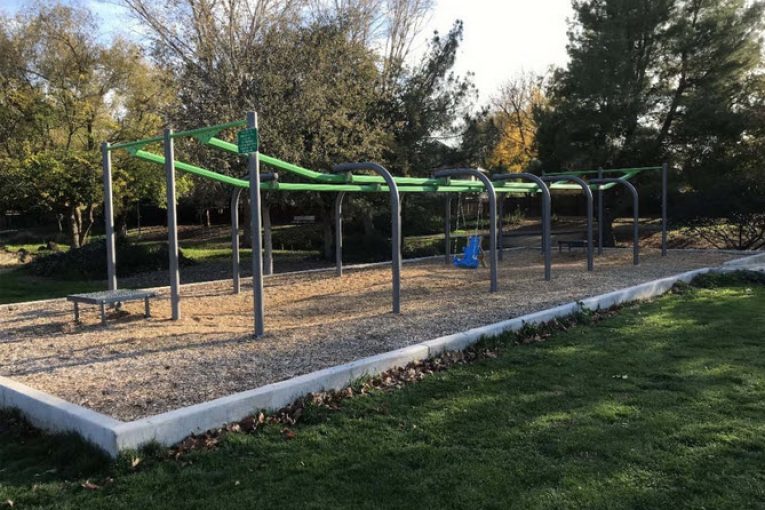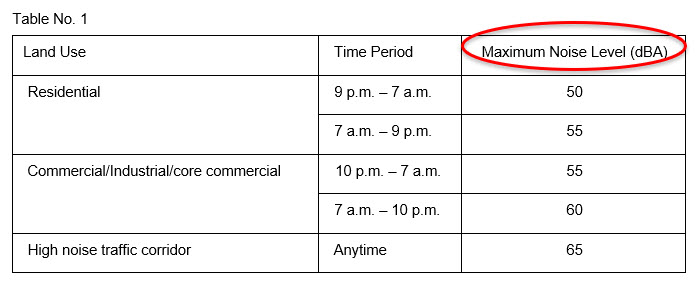

By Robert Canning
Almost a year ago, City of Davis staff attempted to slip a change to the City’s sound ordinance through the city council with little discussion and no commission input. The proposal was pulled back by staff after questions immediately arose about the intent and substance of the change, and how they related to a controversial (and noisy) piece of playground equipment in Arroyo Park.
Now, the staff are bringing a new proposal to the Recreation and Park Commission and asking the commission to review the report of a sound consultant and give “feedback” on new locations for the Sky Track equipment based on the staff report and a survey of Davis residents who live within 1,000 feet of the equipment. The staff report quotes at length from and discusses the sound consultant’s report. But basically, the sound consultant parrots the line from a year ago that the city should use the average of sound over time rather than the maximum allowable sound as the basis to evaluate  whether the Sky Track produces is too noisy.
whether the Sky Track produces is too noisy.
It is puzzling why the consultants continue to use the Leq metric since that does not appear anywhere in the Davis Municipal Code section on sound (Sec. 24.020). In fact the ordinance specifically states that “Noise Level means the maximum continuous sound level or repetitive peak level produced by a sound source or group of sources…” It’s unclear why the staff report states on page 2 of the report that the consultants “determine that the “City Standard is a Leq”. Isn’t it the city’s job to tell the consultants what the code says? We shouldn’t be asking noise consultants to give a legal interpretation of the city code – to the city. And there is no timeframe referenced in the city code, which would be required if an average measurement is to be used. A change in the language of the ordinance regarding maximum allowable sound levels, as has been pointed out before, has ramifications beyond the issue of Arroyo Park and are akin to last year’s fiasco should not be contemplated without more public input.
In addition, the staff report directly conflicts with the municipal code. Below is the table displayed in the staff report under question 7 of the staff to consultants.

Yet the city’s code section 24.02.020 Noise Limits, shows the following table:

For comparison, a vacuum cleaner is about 75 dBA, a refrigerator 55 dBA, and city traffic 85 dBA (see https://ehs.yale.edu/sites/default/files/files/decibel-level-chart.pdf).
Another point: the staff report misrepresents “precision” and “accuracy.” An instrument’s precision is usually the range (plus or minus some value) around the target value to be measured which gives the observer confidence that “most” of the time (say 95 out of 100 times) the instrument is accurate. Precision is independent of the source of sound to be measured and is often based on a control measure (like a standard tone). Accuracy is how close to the “target” the measurement is. For instance, a measurement of sound from one mile away would be much less accurate than one made within one meter.
Sound impacts at Arroyo Park are predicted – using the unfounded Leq, or average standard – to be within .5 dBA of compliance and the measurements have been made with good Type 1 instruments. Now this is what Wikipedia says about accuracy: “For compliance purposes, readings with an ANSI Type 2 sound level meter and dosimeter are considered to have an accuracy of ±2 dBA, while a Type 1 instrument has an accuracy of ±1 dBA.” (https://en.wikipedia.org/wiki/Sound_level_meter) In confusing precision for accuracy, the city is proposing action by the Rec and Park Commission based on readings not even within the accuracy of the measurements.
And if all this is not enough, staff continue to have problems with simple math. The numbers below the chart on survey page 5/11 do not match the narrative report on page five of the staff report. The commission should ask staff to “show their work.”
Last year, the staff made statements that sounded fishy. I stated that staff needed commission input and to rethink their proposals for the sound ordinance to justify questionable decisions of a few years ago. This year they are appropriately coming before the Recreation and Park Commission with information. But the information appears flawed, and the staff’s report of their own survey makes no sense based on the numbers provided in the report.
These sorts of shenanigans and poor work on the part of staff have come up more frequently in the last few years. It’s time for the city council to demand better results from staff. Unfortunately, the city manager’s comment that “I think more work needs to be done on this item…” is still true.
Robert Canning is a Davis resident, a retired psychologist at CDCR and former Vanguard Board member.

This is incorrect. Precision pertains to the least-count value of the reported measurement, and generally corresponds with repeatability. It is untethered from accuracy, i.e. an instrument can be very precise and wildly inaccurate at the same time.
Think of shooting a gun at a bullseye target. If you shoot 10 rounds that are grouped close together at the outer edge of the target, you’re precise but not accurate. If you shoot 10 rounds that are distributed evenly around the outer edge of the target, you’re accurate but not precise. If you group all 10 rounds close to the bullseye, you’re both accurate and precise.
Good analogy…
Surveyors know this stuff…
I stand corrected.